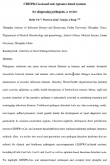CRISPR-Cas-based and Aptamer-based systems for diagnosing pathogens: a review
Abstract
Pathogenic infections can cause severe clinical illnesses in humans and animals. Increased encounters between humans and animals and constant environmental changes exacerbate the transmission of zoonotic infectious diseases. Recently, World Health Organization has declared some zoonotic epidemics as public health emergencies of international concern. Hence, rapid and accurate detection of the causative pathogen is particularly essential in combating emerging and reemerging infectious diseases. Traditional pathogen detection tools are time-consuming, costly, and require skilled personnel, which greatly hinder the development of rapid diagnostic tests particularly in resource-constrained regions. Clustered regularly interspaced short palindromic repeats (CRISPR-)-Cas- and aptamer-based platforms have replaced traditional pathogen detection methods. Here, we review two novel next-generation core pathogen detection platforms that are utilized for clinical and foodborne pathogenic microorganisms: CRISPR-Cas-based systems, including dCas9, Cas12a/b, Cas13, and Cas14 as well as, aptamer-based biosensor detection tools. We highlight CRISPR-Cas- and aptamer-based techniques and compare their strengths and weaknesses. CRISPR-Cas-based tools require cumbersome procedures such as nucleic acid amplification and extraction, while aptamer-based tools require improved sensitivity. We review the combination of CRISPR-Cas- and aptamer-based techniques as a promising approach to overcome these deficiencies. Finally, we discuss Cas14-based tools as functionally stronger platforms for the detection of non-nucleic acid targets.


